► Dacia Spring road trip in Romania
► Europe’s cheapest electric vehicle (EV)
► Adventure awaits… but will the range last?
There are great driving roads and then there’s the Transfagarasan highway. Chiselled into the apex of Romania’s Carpathian mountains, it’s as if a supreme being reached down from the heavens and laid out the finest Scalextric track for his or her pleasure.
In truth the architect was closer to the devil, Nicolae Ceausescu, Romania’s head of state from 1967 to 1989. Ceausescu ordered a highway be built into the mountains, to act as an escape route for him and his army should the Soviet Union march on Bucharest. Labouring at an elevation of 2000 metres from 1970 to 1974, a workforce of army personnel and convicts used six million kilos of dynamite to reshape the sheer cliff faces for a road. Many lives were lost.
Today, the Transfagarasan highway is a spectacular playground for cyclists, bikers, walkers, holidaymakers and car lovers. We’re going to discover it in the Dacia Spring, Europe’s cheapest electric car. With a maximum range of just 137 miles, and 64bhp.
The temperature is a ferocious 37C as we size up the Lichen Kaki-coloured Dacia Spring on Bucharest’s western perimeter. It radiates the charm of small things, mixing a footprint not much longer than a Fiat 500 with chunky SUV body protection. This is a flagship Extreme model, denoted by Copper Brown flourishes on the side mirrors, roof bars and interior. The wheels stretch to 14 inches in diameter.
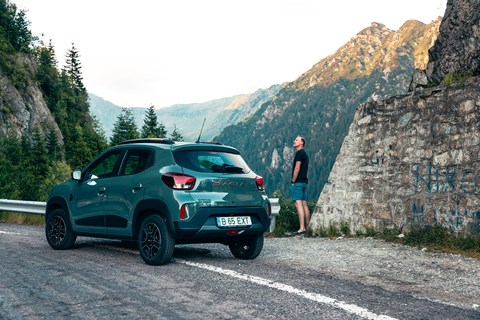
You start the Spring by putting an ancient Renault key in the ignition barrel and turning it. In two days I never truly fathom the starting protocol. Eventually there’s a beep and I select R, appreciate the luxury of a rear camera view, then reverse, swivel to D and exit the car park.
At the first junction we need to cross two lanes of fast-flowing traffic, stop in a central safe spot the size of a lily pad then elbow our way into the stream rushing west. And we wait. Then a gap! I clump the accelerator and the Spring lurches forward, then I jump on the brake to land in the safety zone. Safety? The Spring’s overhanging nose looks destined to take a punch and its rump is indecently exposed, despite the car measuring just 3734mm long.
After another tense wait, with no pedestrians, lights or road furniture to slow the flow, I go for it despite an onrushing white van and Dacia Logan taxi. Swinging the light, rubbery steering, the Spring arcs across the dual carriageway and picks up speed: made it without crashing in the first mile!
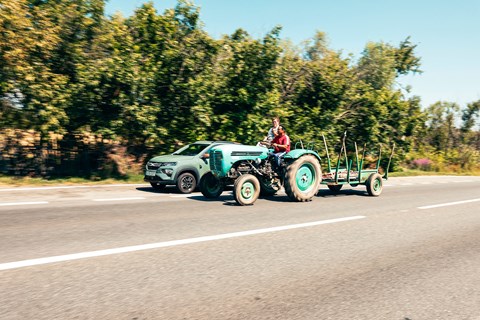
I’m instantly grateful for the Spring’s driveability. The accelerator is responsive, the brakes punchy, and while 64bhp sounds laughable in an age of 400bhp hot hatches, the Dacia feels far more spritely than its 13.7sec 0-62mph sprint suggests. The motor is tuned for a quick getaway and surging up to urban speeds, summoning 83lb ft of torque. And it’s sweetly vocal, humming sonorously as it spins up or down.
The slightly raised driving position gives decent visibility and the seats are comfy but the air-con feels a bit powder-puff in the oppressive sun. Rear space is tight and the boot small.
The Spring lands in the UK in autumn 2024. It’s been on sale in mainland Europe for a few years, with more than 120,000 sold, and now it’s headed our way, with some cosmetic tweaks and new safety equipment. Expect to pay from around £18,000. You can spot the cost-saving everywhere: the doors feel as robust as a Quality Street tin lid, the steering wheel doesn’t adjust, the door bins are unlined, no vanity mirrors. But there is Apple CarPlay to help us navigate.
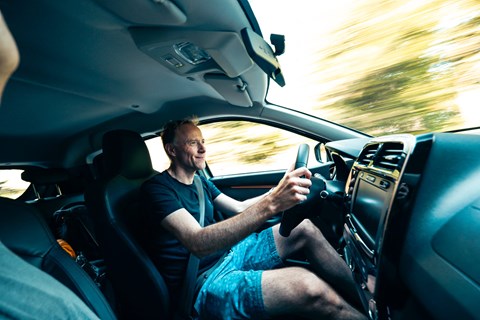
Soon we pass Bucharest’s city limits on the E81 motorway, heading for the town of Pitesti. The distance from Bucharest to Bâlea Lake, the Transfagarasan’s focal point, is only 143 miles on the direct E81 and DN7C, to use the twisting highway’s official designation.
But that’s beyond the Spring’s combined range on the WLTP test cycle – a standard that is far more gentle than our climb in extreme heat, which involves an increase in elevation of 1900 metres. Plus there’s no potent charging on the DN7C, just a few 7kW slow chargers listed on Plugshare.
Our alternative route involves a 75-mile detour, shadowing the snaking Olt river valley and climbing to the town of Sibiu, before heading east to pick up the Transfagarasan from the other side of the mountain. That’s a full day’s driving, with potentially three charging stops. And that assumes I can work the 50kW DC chargers.
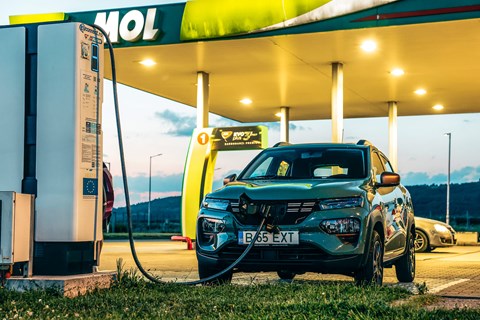
That’s why the basic digital speedo sits consistently at 110kmh (68mph) as I suss out the Spring’s efficiency. The Linglong Green-Max HD tyres and buffeting wind duet in a cacophony of motorway noise. Dacia must keep insulation to a minimum for cost and weight reasons, with a splendid outcome: this Extreme Electric 65 weighs less than a tonne. Eat that, Lotus Eletre!
The vista is dull: endless rapeseed fields punctuated by pockets of Germanic-looking homes – we could be driving through the monotonous North German Plain. Occasionally a burst of sunflowers breaks the tedium, or some cavalier health and safety: a road worker walking fearlessly beside the central armco spraying weedkiller, bare-chested strongmen shovelling asphalt in the blistering sun. Only the speck of mountains on the horizon hints at what’s to come.
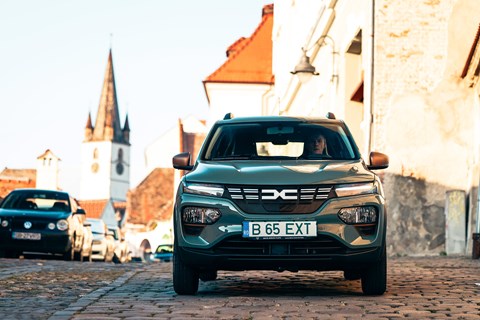
I pin the throttle and chase the 130km/h (81mph) highway limit. While the 80 to 110km/h midrange is adequate, top-end acceleration resembles driving through that glutinous asphalt. The digital read-out gradually ticks upwards – 124, 125, 127, 129. Come on Spring, you can do it! After about 20 seconds, the hallowed 130km/h appears, which the Spring can just about maintain. But there’s not a digit more – no surprise given the official v-max is 125km/h.
The suspension is extremely soft, and like many basic cars there’s no rear anti-roll bar. So the Spring rides cushily over bumps and can skip lightly through potholes, but the nose wanders at motorway speeds, and bodyroll is so pronounced you feel the car listing during even a simple lane change. Passing HGVs needs two hands on the wheel.
After 60 miles, we exit the E81 to find the first charger at a vast Petrom fuel station. Exiled to a sunbaked corner where weeds poke through the paving, its instructions are thankfully in English as well as Romanian. I download the Eldrive app and get the 50kW DC unit charging and, despite a software wobble halfway through, brim the modest 26.8kWh battery. With the heat, the charge takes almost an hour and yields only 101 miles of range. We’re going to need that second pitstop.
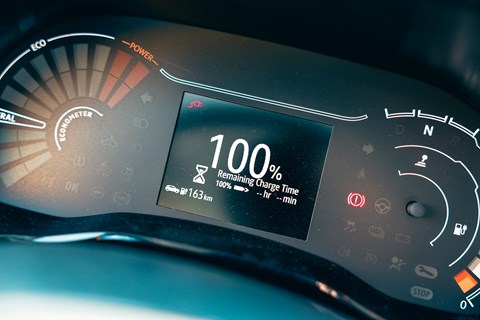
Shortly after Pitesti, the DN7 splits and the Transfagarasan ‘C’ section peels off northwards. But we stay on the DN7 and the two-lane motorway becomes a single-lane highway, choked with HGVs. With the heavy traffic and the Spring’s lack of overtaking punch, we slot helplessly into this wagon train. But it means we finally get to see Romanian life through our windows: compact, whitewashed houses with red-tiled roofs, grassy pavements, pockets of non-corporate industry, the odd horse and cart, lush trees all around. We pass several modest-looking roadside shrines and religious iconography, reminders of Romania’s strong Christian faith.
But love thy neighbour doesn’t extend to anyone slowing the traffic. Even though slip lanes are rare, vehicles get mercilessly beeped for having the temerity to turn left. Thankfully the Spring has a sharp turning circle, and spins up to speed quickly to nip insouciantly between those intimidating HGVs that don’t give an inch. Romania feels like a country in a hurry, and we witness some wonderfully committed overtakes.
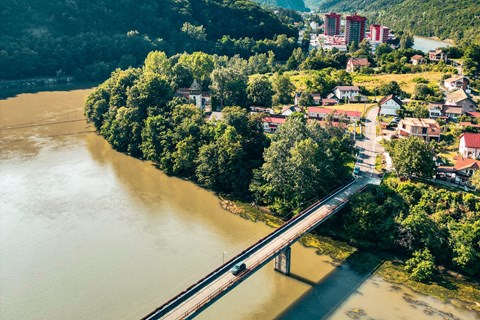
Every so often the uphill grind inexplicably makes way for a section of Spa-Francorchamps. Suddenly there’s an overtaking lane because of the gradient, and I see a chance to dart into it to pass the HGV, Mercedes Sprinter van and Porsche Cayenne in front. I’ll need to get out ahead of a Suzuki coming up fast behind me, however. The prize is a clear path.
We beat the rush at the souvenir stall through some fast-flowing S-bends. I go for it, making the most of the e-motor’s lowdown sweet spot and sail forwards. Just one problem: hard acceleration approaching a fast corner is the perfect recipe for Spring understeer. The nose starts feeling light, the skinny Green-Max HP tyres squeal hideously and the only ‘run off’ area to my left is the DN7 southbound packed with hurtling HGVs. It’s a certain head-on if the tyres let go.
But they don’t. Keeping the accelerator steady like I’m handling an unexploded bomb, the Spring hauls itself around the corner, body leaning extravagantly. My hands relax on the plastic steering wheel and an important lesson in Spring driving is mentally filed.
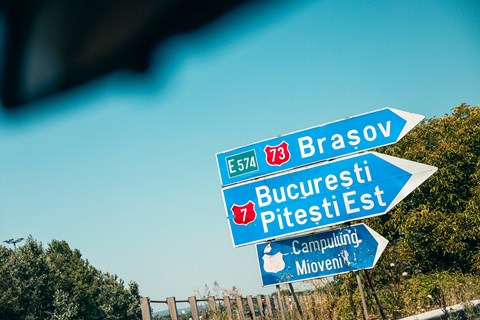
The steep right-hander into Dedluesti is one of several hairpins that enliven the E81. Just think about that: hairpins on a major highway – like getting HGVs to tackle Spa’s La Source. Today they’ve gridlocked this sharp corner, and inching down into the village I see why. A strip of restaurants and stalls sell food and goods, and vehicles double-park as they stop at these services. Naturally I follow suit, and grab a £2.60 grilled chicken sandwich from Restaurant Beby’s hot coals.
Soon it’s time for a precautionary charge at Râmnicu Vâlcea, despite having covered only 45 miles (in 145 minutes!) and with 64 per cent battery remaining. A Tesla Model Y is using our planned 50kW charger, but outside the neighbouring Pepco clothes store is a 120kW DC charger. Not that the Spring can take full advantage: its DC max is 30kW. The e-Dacia sups 9kWh in 40 minutes, for 17.82 Romanian lei – just over £3.
We slice through the town and the traffic thins in the early evening as the DN7 climbs north beside the Olt river. The wooded hillsides step closer to hem us in, then the dramatic grey cliffs appear as steepness slims the forests. We pass through Calimanesti, which resembles the Swiss Alps with its wide boulevard, grand hotels and manicured streets.
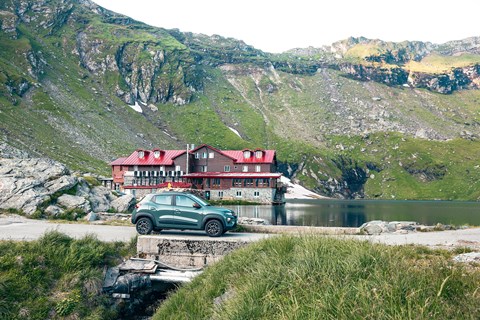
After niggling corrections on the motorway and the drama of the sweepers, the Spring feels happier strolling along this 30-mile stretch. The steering swings more sweetly from sweeping corner to corner, the motor hums merrily, the tyre roar more muted.
Our destination is Sibiu, European Capital of Culture in 2007 and one of Romania’s most beautiful cities. The settlement dates back to 1191, and the central old town looks beautiful under the setting sun, with its cobbled streets, red brick facades and distinctive roof venting – slitty inlets shaped like eyes that give the town its Seebiu nickname. Finally this city car is in its natural environment, jinking through busy streets, squeezing past big stone steps on narrow alleyways.
Then I give the Spring its final charge, at the Mol fuel station 12 miles south of the city. It takes 17kWh, promising a range of 102 miles to attack the Transfagarasan at dawn tomorrow. Given it’s a brutal 30-mile climb to Balea Lake, we might need the Spring’s regenerative braking to ensure we make it back. Being stranded in a landscape where bears roam is not an appealing prospect. Tomorrow should be interesting… It’s just after 5am when we begin the ascent in pitch blackness.
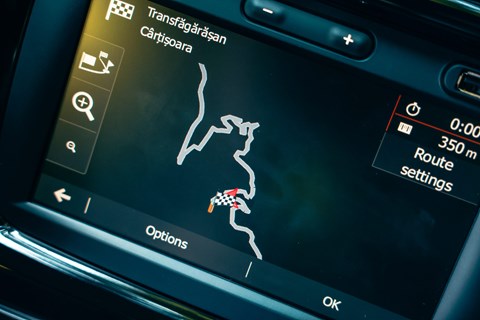
For a while we tail an ambling Ferrari 488, then get harassed by a pick-up driver who’s auditioning for a remake of Spielberg’s Duel, flashing his lights just inches from my bumper despite the Spring running at the 70km/h limit. Unsettled, I let him pass. Then we roll through Cartisoara village, where Romanian flags hang limp in the brightening sky, the last big settlement before the road climbs and the hairpins begin.
The forest is dense with branches overhanging the winding road, and the tarmac good considering extreme snowfall closes the road between October and June. The armco is intermittent: the trees will likely stop a car from sliding down the mountainside, but probably kill you nonetheless. Up and up we climb for mile after mile, not seeing a soul apart from a stray dog lying in the road.
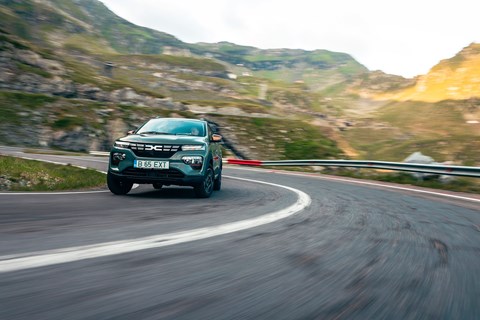
My ears pop three times during the ascent. And then we clear the tree line, emerging into a cavernous green bowl with massive boulders strewn all around. It resembles a lunar landscape, across which pylons carry electricity and cable cars over sheep grazing under a shepherd’s watchful eye. I stop the car and clamber out, drinking in the majesty.
The Transfagarasan highway zig-zags across the valley, then climbs the cliff face. The Romanian army’s suspended concrete slabs ford little crevasses through which waterfalls gush. Curve after curve, carved into the rockface, an invitation to drive. So we drive.
Over the past 24 hours, I’ve been training for this moment, learning how to get the best from the Spring in these corners. Lifting off the throttle wipes up to 10mph off the entry speed and boosts grip. The Spring is close to its limits: the ESP light blinks on and off, the body rolls outwards. Kiss the apex then get on the power and the Spring clings on and sails through. And then we do it again. And again.

The corners come thick and fast. There are patches of compacted snow, rippled by the wind. In some turns my imprecision triggers a squeal of 165/70 R14 rubber. The Spring definitely prefers sweepers to hairpins where its lack of grip – unusual for a modern car – can make a hash of tight turns.
It’s before 7am and the road is still empty, aside from the odd performance car; we enjoy fly-bys from a Mitsubishi Evo X, Nissan R35 GT-R on Swiss plates, Ford Mustang and an Audi RS5 (complete with passenger holding a GoPro out the window on a selfie stick).
We reach the summit. Beside the entrance to the tunnel breaching the other side of the mountain there are two big car parks charging £10 to park. A strip of ramshackle huts sell Transfagarasan fridge magnets, bear memorabilia and honey, and I devour spicy sausages, fried potatoes and espressos in a vast food tent.

The Spring has made it, with 48 miles of range remaining. Emissions standards may have killed off petrol city cars, while electrification has put prices up and made motoring less accessible. But the Spring is the antidote to both those trends, preserving freedom for the cost-conscious in the electric age. It’s the little electric car that ventured out of its urban comfort zone and climbed a mountain. It’s the electric Panda, years before Fiat gets its rival to market.
We trundle it up to Bâlea Lake, but it lacks visual impact after everything we’ve seen: its famous ice hotel has melted, scruffy dogs cavort.
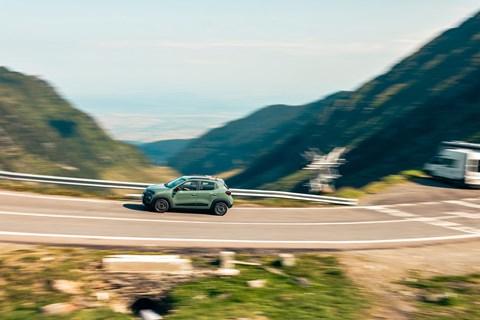
So I park the Spring on an adjacent cliff edge and look around. Mournful birdsong calls for company, horseflies buzz, the long grass and buttercups blow in the whistling wind. And stretching down into the valley is that incredible ribbon of tarmac.
We drove the highway to heaven in a Dacia Spring. Next time I might bring a Ferrari, though.